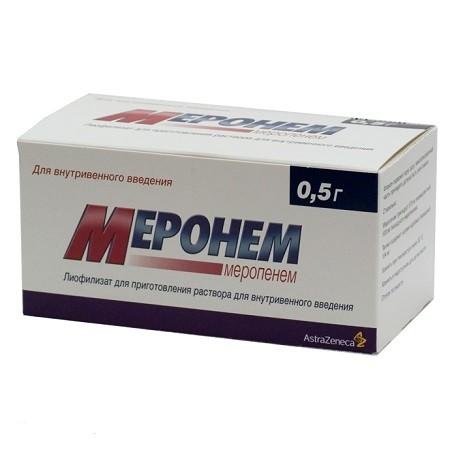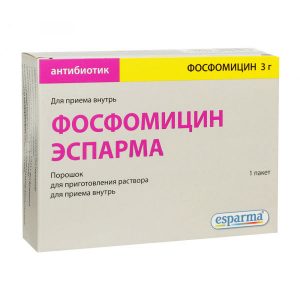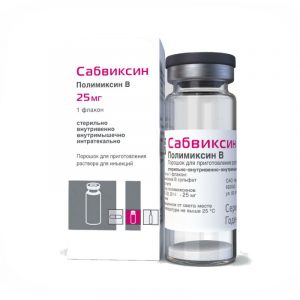Description
Latin name
MERONEM
Release form
Lyophilisate for preparation of solution for intravenous administration
Packing
In a package of 10 bottles of 500 mg.
Pharmacological action of
Meropenem is an antibiotic from the group of carbapenems for parenteral use that is resistant to human dehydropeptidase-1 (BPH-1), does not require additional administration of a BPH-1 inhibitor.
Meropenem has a bactericidal effect due to the effect on the synthesis of the bacterial cell wall. The powerful bactericidal effect of meropenem against a wide range of aerobic and anaerobic bacteria is explained by a high ability to penetrate the bacterial cell wall, a high level of stability to most β-lactamases, and a significant affinity for penicillin binding proteins (BSP). Minimum bactericidal concentrations (MBC) are usually the same as well as minimal inhibitory concentrations (MICs). For 76% of the tested bacterial species, the MBK / MIC ratio was 2 or less.
Meropenem is stable in pathogen susceptibility tests. In vitro tests show that meropenem acts synergistically with various antibiotics. It was shown in vitro and in vivo that meropenem has a postantibiotic effect.
The only recommended criteria for sensitivity to meropenem are based on the pharmacokinetics of the drug and on the correlation of clinical and microbiological data – the diameter of the zone and MIC determined for the respective pathogens.
The in vitro spectrum of antibacterial activity of meropenem includes almost all clinically significant gram-positive and gram-negative aerobic and anaerobic microorganisms.
The drug is active against aerobic gram-positive bacteria: Bacillus spp., Corynebacterium diphtheriae, Enterococcus liquifaciens, Enterococcus avium, Listeria monocytogenes, Lactobacillus spp., Nocardia asteroids, production-producing, and urea-producing ( including Staphylococcus saprophyticus, Staphylococcus capitis, Staphylococcus cohnii, Staphylococcus xylosus, Staphylococcus warneri, Staphylococcus hominis, Staphylococcus simulans, Staphylococcus intermedius, Staphylococcus sciuri, Staphylococcus lugdenensis, Streptococcus pneumoniae (sensitive and penicillin-resistant), Streptococcus agalactiae, Streptococcus pyogenes, Streptococcus equi, Streptococcus bovis, Streptococcus mitis, Streptococcus mitior, Streptococcus milleri, Streptococcus sanguis, Streptococcus viridans, Streptococcus salivarius, Streptococcus morbillorum, Streptococcus group G, group F, Rhodococcus equi.
Aerobic Gram-negative bacteria: Achromobacter xylosoxidans, Acinetobacter anitratus, Acinetobacter lwoffii, Acinetobacter baumannii, Aeromonas hydrophila, Aeromonas sorbria, Aeromonas caviae, Alcaligenes faecalis, Bordetella bronchiseptica, Brucella melitensis, Campylobacter coli, Campylobacter jejuni, Citrobacter freundii, Citrobacter diversus, Citrobacter koseri. , Citrobacter amalonaticus, Enterobacter aerogenes, Enterobacter agglomerans, Enterobacter cloacae, Enterobacter sakazakii, Escherichia coli, Escherichia hermannii, Gardnerella vaginalis, Haemophilus influenzae (strains producing β-lactlaminus influenzae, Haefelophysidae, Haemophilus influenzae, Haemophilus influenzae, and Shigella dysenteriae, Vibrio cholerae, Vibrio parahaemolyticus, Vibrio vulnificus, Yersinia enterocolitica.
of Anaerobic bacteria: Actinomyces odontolyticus, Actinomyces meyeri, Bacteroides-Prevotella-Porphyromonas spp, Bacteroides fragilis, Bacteroides vulgatus, Bacteroides variabilis, Bacteroides pneumosintes, Bacteroides coagulans, Bacteroacteriidesidesidesisis, Prevotella buccalis, Prevotella corporis, Bacteroides gracilis, Prevotella melaninogenica, Prevotella intermedia, Prevotella bivia, Prevotella splanchnicus, Prevotella oralis, Prevotella disiens, Prevotella rumenicola, Prevotella ureolyticus, Prevotella oris, Prevotella buccae, Prevotella denticola, Prevotella levii, Porphyromonas asaccharolyticus, Bifidobacterium spp , Bilophilia wadsworthia, Clostridium perfringens, Clostridium bifermentans, Clostridium ramosum, Clostridium sporogenes, Clostridium cadaveris, Clostridium sordellii, Clostridium butyricum, Clostridium clostridiiformis, Clostridium innocuum, Clostridium subterminale, Clostridium tertium, Eubacterium lentum, Eubacterium aerofaciens, Fusobacterium mortiferum, Fusobacterium necrophorum, Fusobacterium nucleatum , Fusobacterium varium, Mobiluncus curtisii, Mobiluncus mulieris, Peptostreptococcus anaerobius, Peptostreptococcus micros, Peptostreptococcus saccharolyticus, Peptococcus saccharolyticus, Peptococentocentcus peptocococcus asaccharolyticus, Peptococentcus peptocococcus asaccharolyticus, Peptococibcus asaccharolyticus, Peptococibcus asaccharolyticus, Peptococibcus asaccharolyticus, Peptococibcus asaccharolyticus, Peptococibcus asaccharolyticus, Peptococibcus asaccharolyticus, Peptococibcus asaccharolyticus, Peptococibcus asaccharolyticus, Peptococpcus asaccharolyticus
Stenotrophomonas maltophilia resistant to the drug, Enterococcus faecium and methicillin-resistant staphylococci.
Meronem has been shown to be effective as monotherapy or in combination with other antimicrobial agents in the treatment of polymicrobial infections.
Indications
Treatment of the following infections in children and adults caused by one or more pathogens sensitive to the drug:
– Pneumonia (including nosocomial).
– Urinary Tract Infections.
– Abdominal infections.
– Gynecological infections (such as endometritis and inflammatory diseases of the pelvic organs).
– Infections of the skin and soft tissues.
– Meningitis.
– Septicemia.
– Empirical therapy for suspected bacterial infection in adult patients with febrile episodes due to neutropenia, as monotherapy or in combination with antiviral or antifungal drugs.
Contraindications
Hypersensitivity to the drug. With caution, the drug should be prescribed simultaneously with potentially nephrotoxic drugs, as well as patients with dyspepsia symptoms, especially associated with colitis.
Pregnancy and lactation
The safety of Meronem during pregnancy has not been studied.
Experimental animal studies have not shown any adverse effects on the developing fetus. The only adverse event identified in animal studies on the effect of the drug on the reproductive system was the increased frequency of abortions in monkeys with a dose 13 times the recommended for humans.
Meronem should not be used during pregnancy, unless the potential benefit of its use does not justify the possible risk to the fetus. In each case, the drug must be used under the direct supervision of a doctor.
Meropenem is determined in very low concentrations in the breast milk of animals. Meronem should not be used during lactation (breastfeeding), unless the potential benefit of its use does not justify the possible risk to the child. If necessary, use of the drug during lactation should consider stopping breastfeeding.
Composition
Lyophilisate for solution preparation contains: meropenem trihydrate 570 mg in 1 bottle, which corresponds to the content of meropenem 500 mg
Excipients: sodium carbonate anhydrous.
Dosage and administration of
For adults, the dosage regimen and duration of therapy are determined depending on the type and severity of the infection and the patient’s condition. The following daily doses are recommended.
In the treatment of pneumonia, urinary tract infections, gynecological infections (endometritis and pelvic inflammatory diseases), infections of the skin and soft tissues – 500 mg iv every 8 hours
In the treatment of hospital pneumonia, peritonitis, suspected bacterial infection in patients with neutropenia, as well as septicemia – 1 g iv every 8 hours.
In the treatment of meningitis – 2 g iv every 8 hours.
Meropenem is excreted during hemodialysis, therefore, if further treatment is required, it is recommended that the unit doses (determined in the head depending on the type and severity of the infection) was administered at the end of the hemodialysis procedure to restore the effective plasma concentration.
Experience with Meronem in patients undergoing peritoneal dialysis is limited.
Patients with hepatic impairment do not need dose adjustment.
In elderly patients with normal renal function or CC greater than 50 ml / min, dose adjustment is not required.
For children aged 3 months to 12 years, the recommended dose for iv administration is 10-20 mg / kg every 8 hours, depending on the type and severity of the infection, the sensitivity of the pathogen and the patient’s condition. In children weighing more than 50 kg, the same doses should be used as in adults.
For meningitis, the recommended dose is 40 mg / kg every 8 hours.
Rules for the preparation and administration of
Meronem solution should be given as an intravenous bolus injection for at least 5 minutes or as an intravenous infusion for 15-30 minutes .
For iv bolus injections, Meronem should be diluted with sterile water for injection (5 ml per 250 mg of meropenem), which provides a solution concentration of 50 mg / ml.
For intravenous infusion, Meronem should be diluted with sterile water for injection or a compatible infusion fluid and then diluted (up to 50-200 ml) with a compatible infusion fluid.
Meronem is compatible with the following infusion fluids: 0.9% sodium chloride solution for intravenous infusion 5% or 10% glucose solution for intravenous infusion 5% glucose solution for intravenous infusion with 0.02% sodium bicarbonate solution 0.9% sodium chloride with 5% glucose solution for intravenous infusion 5% glucose solution with 0.225% sodium chloride solution for intravenous infusion 5% glucose solution with 0.15% potassium chloride solution for intravenous infusion with 2.5% mannitol solution or 10% for / in infusion.
Meronem should not be mixed with solutions containing other drugs.
Shake the diluted solution before use. All single use vials. When breeding Meronem, standard aseptic rules should apply.
Drug Interaction
Probenecid competes with meropenem for active tubular secretion and thus inhibits renal excretion of meropenem, causing an increase in its half-life and plasma concentration. Since the efficacy and duration of Meronem without probenecid are adequate, co-administration of probenecid with Meronem is not recommended.
Possible effect of Meronem on metabolism and protein binding of other drugs has not been studied. However, given the low binding of meropenem to plasma proteins (about 2%), it can be assumed that interactions with other drugs should not be.
Meronem was administered while taking other drugs, without any adverse pharmacological interactions.
Meronem may reduce the level of valproic acid in the serum. Some patients may be below the therapeutic level.
However, there are no specific data on possible drug interactions.
Overdose
Accidental overdose is possible during treatment, especially in patients with impaired renal function.
Treatment: carry out symptomatic therapy. Normally, there is rapid elimination of the drug by the kidneys. In patients with renal impairment, hemodialysis effectively removes meropenem and its metabolites.
Storage conditions
The drug should be stored out of the reach of children at a temperature not exceeding 30 ° C.
Expiration
4 years.
Deystvuyuschee substances
Meropenem
pharmacy terms
dosage form
dosage form
injection solution



